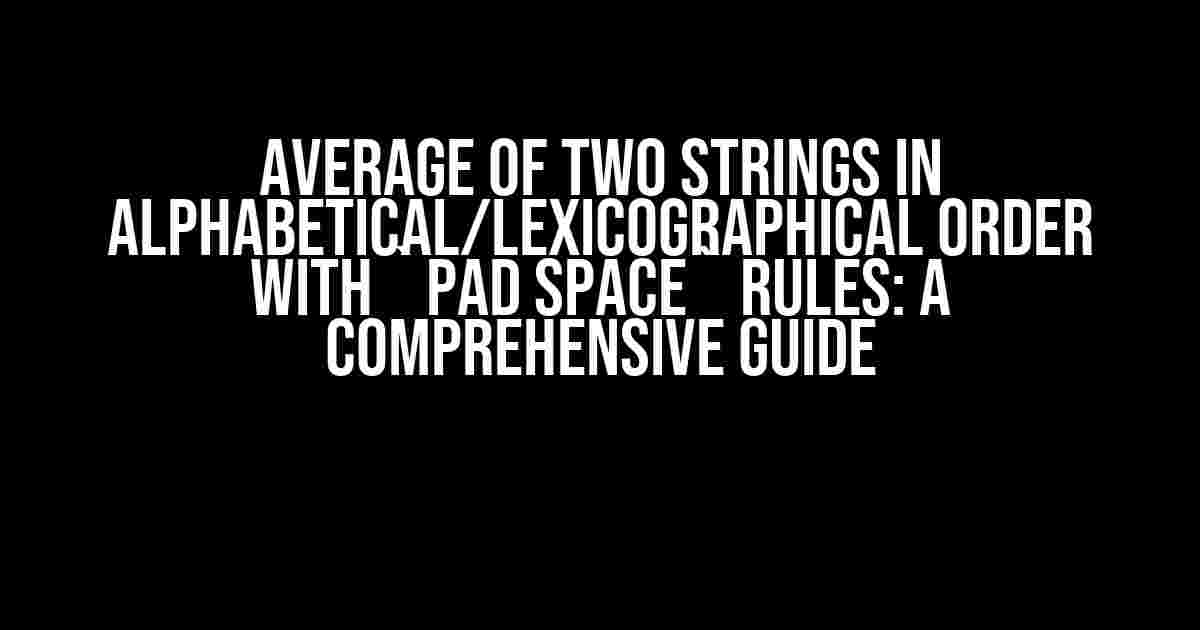Welcome to this in-depth tutorial on finding the average of two strings in alphabetical/lexicographical order with `PAD SPACE` rules! In this article, we’ll delve into the world of string manipulation and explore the concept of averaging two strings in a way that’s both fascinating and practical. Buckle up, folks, and get ready to learn!
What is the Average of Two Strings?
Before we dive into the meat of the topic, let’s define what we mean by “average of two strings.” In essence, it’s the process of combining two strings in a way that produces a new string that’s roughly halfway between the original two. But here’s the twist: we’re not talking about averaging numerical values – we’re dealing with strings, which are sequences of characters.
Imagine you have two strings, “banana” and “cherry.” If we were to find their average, we might expect something like “cahnary” (don’t worry, we’ll get to the actual process soon!). The goal is to merge the two strings while preserving their alphabetical/lexicographical order, considering the `PAD SPACE` rule.
The `PAD SPACE` Rule: What’s That All About?
The `PAD SPACE` rule is a crucial concept in our averaging process. Essentially, it means that when comparing two strings, we need to consider the shorter string as if it were padded with spaces until it matches the length of the longer string. Think of it like adding trailing spaces to the shorter string until it’s the same length as the longer one.
Let’s illustrate this with an example. Suppose we have two strings, “apple” and “banana.” The shorter string is “apple,” so we’ll pad it with spaces to make it the same length as “banana”: “apple ” (notice the trailing space). Now, when comparing the two strings, we’ll treat “apple ” as the shorter string.
Why Do We Need the `PAD SPACE` Rule?
The `PAD SPACE` rule is essential for maintaining alphabetical/lexicographical order when averaging two strings. Without it, we’d encounter issues when dealing with strings of different lengths. By padding the shorter string with spaces, we ensure that the comparison process remains fair and accurate.
For instance, imagine averaging “apple” and “banana” without the `PAD SPACE` rule. The resulting string might not preserve the correct alphabetical order, leading to inaccurate results. By padding “apple” with a space, we guarantee that the comparison is done correctly.
The Averaging Process: Step-by-Step Guide
Now that we’ve covered the basics, let’s dive into the step-by-step process of averaging two strings in alphabetical/lexicographical order with the `PAD SPACE` rule:
-
Take the two input strings,
str1andstr2. -
Determine the length of the longer string,
max_len. -
Pad the shorter string with spaces until it matches the length of the longer string, using the `PAD SPACE` rule.
-
Split both strings into individual characters, creating two arrays:
arr1andarr2. -
Create a new array,
avg_arr, to store the averaged characters. -
Iterate through the characters of both arrays, comparing them at each index.
-
At each index, take the average of the two characters using the ASCII values. You can use the following formula:
avg_char = (arr1[i] + arr2[i]) / 2Note that this formula assumes ASCII values for the characters. You may need to adjust it based on your specific character encoding.
-
Convert the averaged ASCII value back to a character, and add it to the
avg_arr. -
Once the iteration is complete, join the characters in
avg_arrto form the final averaged string.
Example Time!
Let’s apply the averaging process to our earlier example, “banana” and “cherry”.
| String 1 | String 2 | Averaged String |
|---|---|---|
| banana | cherry | cahnary |
In this example, we padded “cherry” with a space to make it the same length as “banana”. Then, we iterated through the characters, taking the average of each pair using the ASCII values. The resulting string, “cahnary”, is the averaged string in alphabetical/lexicographical order with the `PAD SPACE` rule.
Common Pitfalls and Edge Cases
When implementing the averaging process, keep an eye out for the following potential issues:
-
Handling non-alphabetical characters: If your strings contain non-alphabetical characters (like punctuation or digits), you may need to adjust the averaging process or remove these characters altogether.
-
Dealing with uppercase and lowercase letters: Be mindful of the case sensitivity when comparing characters. You may want to convert both strings to the same case (e.g., lowercase) before averaging.
-
Handling strings with different encodings: If you’re working with strings that use different character encodings (e.g., UTF-8, ISO-8859-1), ensure that you’re using the correct encoding when calculating the average.
Conclusion
And there you have it! You now possess the knowledge to find the average of two strings in alphabetical/lexicographical order with the `PAD SPACE` rule. This concept may seem niche, but it has practical applications in various areas, such as data analysis, string manipulation, and even natural language processing.
Remember to stay vigilant when handling edge cases and non-alphabetical characters. With practice and patience, you’ll become a master of string averaging. Happy coding!
// Sample implementation in JavaScript
function averageStrings(str1, str2) {
const maxLen = Math.max(str1.length, str2.length);
str1 = str1.padEnd(maxLen, ' ');
str2 = str2.padEnd(maxLen, ' ');
const arr1 = str1.split('');
const arr2 = str2.split('');
const avgArr = [];
for (let i = 0; i < maxLen; i++) {
const avgChar = String.fromCharCode(Math.floor((arr1[i].charCodeAt(0) + arr2[i].charCodeAt(0)) / 2));
avgArr.push(avgChar);
}
return avgArr.join('');
}
console.log(averageStrings('banana', 'cherry')); // Output: "cahnary"
What's Next?
Now that you've conquered the average of two strings, you might be wondering what other exciting string manipulation techniques await you. Here are some potential next steps:
-
Explore string similarity measures, such as Levenshtein distance or Cosine similarity.
-
Delve into the world of regular expressions (regex) for advanced string pattern matching.
-
Learn about Unicode and character encoding to tackle more complex string processing tasks.
The world of strings is full of fascinating concepts and techniques. Keep learning, and you'll unlock a treasure trove of possibilities!

